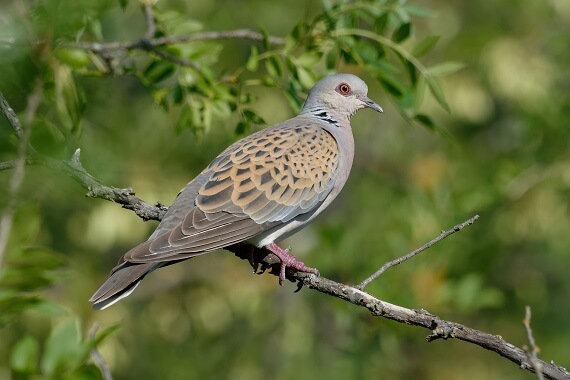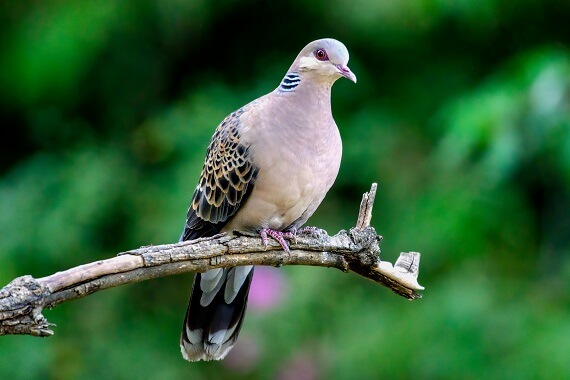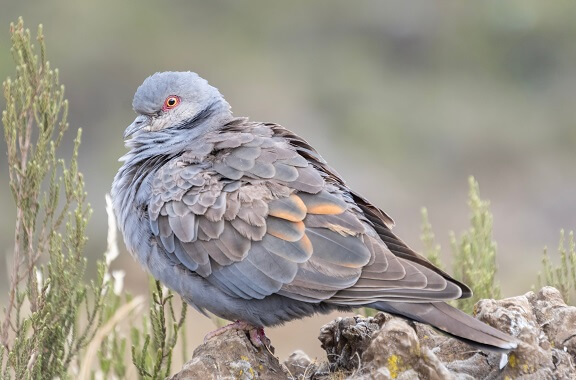
There are several species of turtle dove belonging to the genus Streptopelia in the pigeon and dove family Columbidae. These birds are small-medium in size, with a slim body. Many of the species in this genus have a characteristic black-and-white patch on the neck and make monotonous cooing sounds. There are 13 species belonging to the genus Streptopelia. Four have common names that name them as turtle doves. While each species of dove has unique characteristics, collectively they share many traits that determine breeding, behavior, and appearance. Doves have small heads and narrow, small bills. They have short legs, and their heads bob back and forth as they walk. Turtle doves primarily feed on grass and grain seed, but some will also eat fruits. These birds are most likely to be found in open woodlands and urban areas, although some will take up residence in more densely forested areas. Turtle doves are monogamous and mate for life. Once the female chooses a mate, the males and females work together to build nests made of vegetation. Both parents take turns incubating the eggs, which hatch two to three weeks later. While most species of turtle dove are classified as least concern, the European turtle dove is listed as vulnerable. European turtle doves have suffered a drastic decline in the UK. It is estimated that the population has decreased as much as 98% since 1970. The main threats to this species are diminishing breeding grounds due to human development, changes in agricultural practices, which has reduced food availability, and illegal poaching. They are also shot in large numbers during their migration across Europe. It is estimated that two to four million are hunted and trapped as they migrate through. The European turtle dove is perhaps the most well-known and is commonly just called the turtle dove. This bird is a pinkish-grey in color with a black and white striped patch on its neck. It also has a pink ring around its eyes and white tips on its tail feathers that are most noticeable during flight. They are the only long-distance migratory dove species found in Europe. European turtle doves complete annual migrations from their breeding grounds. They depart in the mid-late summer, through western Europe to their wintering grounds in West Africa, where they stay until the following spring. They usually return to their breeding grounds during April. This turtle dove has dark plumage and a black mark on its neck. Its wing feathers have reddish edges. It is found in a wide variety of habitats, including forest edge, woodland, gardens, and agricultural areas. This bird is found mainly in eastern Africa, with populations in Ethiopia, Kenya, Tanzania, and Mozambique as well as in Yemen in the Middle East. Also known as the pink-bellied turtle dove, this species is closely related to the dusky turtle dove and has been considered the same species as the dusky turtle dove in the past. This bird is native to Cameroon, Nigeria, and south-west Chad, and further west in Gambia, Senegal, and Mali. It is found in a range of habitats, including forests, gardens, and farmland. It is uncertain if it is migratory. Little is known about this bird’s behavior. Generally found in Siberia and parts of east Asia, the oriental turtle dove, or rufous turtle dove, is found in a variety of habitats. They are often observed in agricultural areas, where they feed on grain and seeds. In the summer, they breed in forested areas. Southern populations may be residents all year, but those found at the north of its range will migrate south for the winter. Turtle doves are beautiful birds that are well-known for their cooing sounds. Aside from their beautiful song, these birds have several biological adaptations that help them to adapt to their environment. Let’s investigate further. The European turtle dove is famous for its long migrations, often traveling more than 6,800 miles (approximately 11, 000 km) between Europe and Africa. Birds migrate to overwintering grounds in search of food, as winter in their breeding grounds results in a decrease in resources. Decreasing temperatures and shorter days are cues for the birds that its time to leave, and they begin the long migration to their winter homes. Little was known about the European turtle dove’s migration route until fairly recently. In 2014, a group of researchers fitted a European turtle dove – named Titan – with a small satellite tag in Suffolk, UK, before it began its long migration to Mali in West Africa. Titan flew mostly under cover of darkness, covering 310 – 430 miles (500 – 700 km) a night. On this journey, he crossed many different landscapes, including the Atlas Mountains of North Africa and the Sahara Desert. He visited Senegal, Morocco, and Spain. His maximum speed was 37 miles per hour (60 km per hour), and his journey took him a month to complete. After six months in Africa, Titan made his way back to his breeding ground in the UK. On the way back, he took a different route, spending two weeks crossing France. European turtle doves are on the decline in the UK. It is hoped that by understanding their migration routes and other environment, conservationists can work to protect this species. All doves and pigeons produce crop milk that is used to feed their young after hatch. Despite its name, crop milk does not look like the milk produced by mammals, and, also unlike mammals, it is not only produced by the females. Both the male and female birds can produce this milk, which is soft and lumpy and pale yellow. Crop milk is secreted by specialized cells that are found in the crop wall. It is much higher in protein and fat than either cow or human milk and is the only nourishment the chicks will receive during their first few days of life. The milk is very similar to the food provided to the developing embryos in the egg before hatch. Only a small number of birds produce crop milk. Aside from dove and pigeon species, Emperor penguins and greater flamingos can also produce it. Turtle doves are known to build frail nests that often fall apart, which can result in young and eggs being lost. Due to this, these birds have adapted to have multiple broods per breeding season to increase the chance of some of the chicks surviving. They will often renest immediately if they lose their young. Due to the short incubation periods, turtle doves can raise as many as six broods annually!
Kingdom
Animalia
Phylum
Chordata
Class
Aves
Order
Columbiformes
Family
Columbidae
Genus
Streptopelia
Species
Numerous
Length
10 – 11 inches ( 26 to 28 cm)
Weight
140 g
Lifespan
2 years
Status
Most species are of least concern, European turtle dove is vulnerable
Preferred Habitat
woodland, hedgerows, grassland
Average Clutch size
2
Main food item
Seeds and grains
Main predators
Birds of prey, large mammals
The Basics

Some Turtle Dove Species

Fun Facts about the Turtle Dove!
Migration

Crop Milk
Multiple Broods
